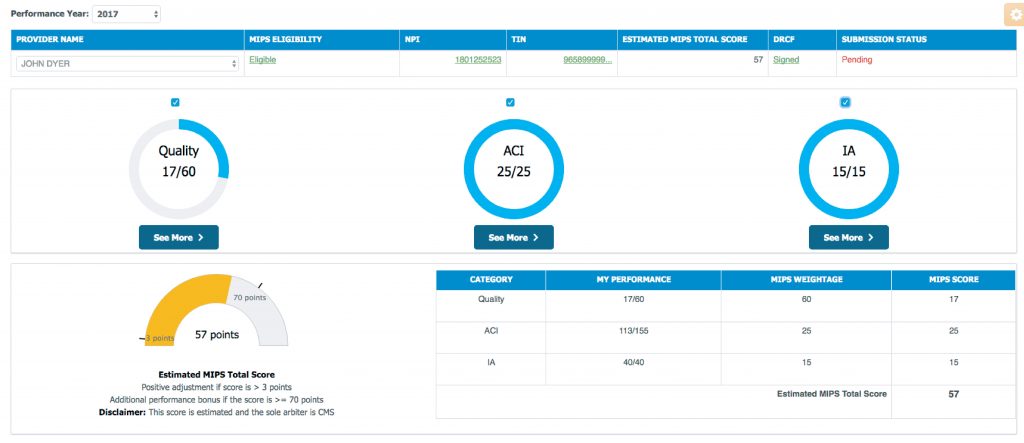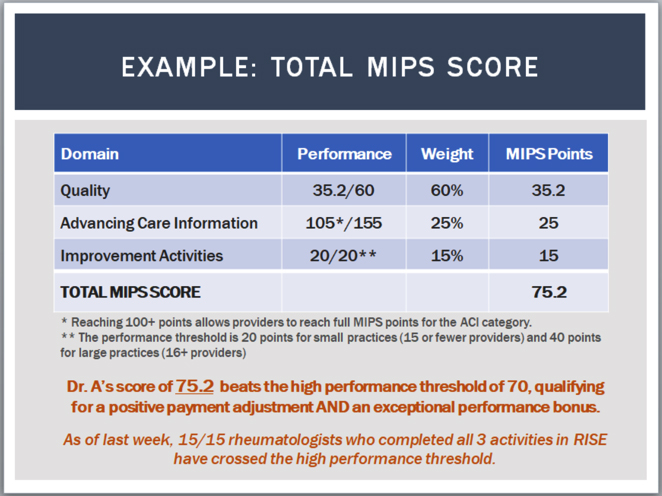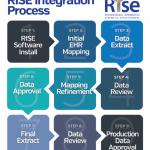Hundreds of rheumatology providers across the country are finalizing submissions for the first year of reporting under the Merit-Based Incentive Payment System (MIPS). According to a presentation at the 2017 ACR/ARHP Annual Meeting in San Diego, providers that participate in and submit through the Rheumatology Informatics System for Effectiveness (RISE) Registry are poised to perform well. The presentation analyzed performance across the three MIPS domains in 2017 for providers participating in the registry. The hundreds in attendance also learned about how the scores for the various MIPS domains are calculated and the advantages RISE provides with regard to optimizing their MIPS scores.
MIPS is one of two pathways laid out under the MACRA legislation to determine payment reimbursements for providers that treat Medicare patients. For the 2017 performance year, more than 3,800 rheumatology providers are expected to report to the Centers for Medicare and Medicaid Services (CMS) through the MIPS pathway.
RISE & MIPS Domains
In her presentation, Jinoos Yazdany, MD, MPH, reviewed the MIPS requirements for 2017 reporting and demonstrated how participation in RISE will positively affect MIPS scores. For 2017, providers reporting through MIPS had the option to not report (which results in a negative payment adjustment of 4%); report only one measure or activity (which results in no negative payment adjustment); submit 90 days of data on all MIPS measures and activities (which results in a neutral or positive payment adjustment); or submit a full year of data on all MIPS measures and activities (which likely results in a positive payment adjustment).
Providers reporting a partial or full year for 2017 are scored on three of the four MIPS domains: quality, improvement activities (IA) and advancing care information (ACI). Reporting in the cost domain will begin in the 2018 reporting year. RISE participants are able to submit their data for all three categories through a new dashboard (see Figure 1) built specifically to help providers track and complete their MIPS reporting requirements as easily as possible.
Together, the improvement activities (IA) and advancing care information (ACI) domains make up 40% of a provider’s final MIPS score, accounting for 15% and 25%, respectively. The vast majority of RISE participants are able to fulfill all the points required under IA because all providers in RISE, a Qualified Clinical Data Registry (QCDR), automatically receive monthly feedback reports, which fulfills a heavily weighted activity. Providers’ performance for the ACI domain is more dependent on the capabilities and use of their electronic health record (EHR) systems. To help document performance, RISE provides a dashboard for providers to enter the necessary data, and RISE participation gives providers a 5% bonus on their ACI points.
The domain with the greatest impact is quality, making up 60% of a provider’s final MIPS score. Under this domain, provider scores are determined by performance on a variety of quality measures. The better providers perform on each quality measure as compared to their peers across the country, the more points they earn. For 2017 reporting, each measure reported, regardless of performance, earns the provider at least three points. Plus, RISE participants can earn up to five bonus points by submitting all the available high-priority and outcome measures in RISE.
Crossing the Threshold
Dr. Yazdany also provided an example of MIPS performance based on aggregate data from RISE participants as of September 2017. Assuming the provider has high performance in the ACI domain with the RISE bonus, fulfills the IA domain as part of a small practice (15 or fewer providers) that participates in RISE and receives monthly reports, and has a mix of low- to medium-high performance on six quality measures and bonus points for submitting extra high priority measures available in RISE, the sample provider earned a total of 75.2 overall MIPS points out of 100 (see Figure 2). Not only does this mean the provider is highly likely to see a positive payment adjustment, it also means the provider crossed the high-performance threshold of 70 total MIPS points and is qualified for an exceptional performance bonus of at least an additional 0.5%. Dr. Yazdany noted that all 15 of the rheumatologists in RISE who had completed all three MIPS domains prior to her presentation had crossed the high-performance threshold. “This is great news, and it suggests that providers [participating in RISE] are going to do very well in this program,” she explained.
The RISE Advantage
The RISE Registry was developed by the ACR to help providers navigate federal reporting requirements and, more generally, to provide a tool that enables quality improvement in rheumatology practices across the country. David Daikh, MD, ACR president, says it’s a tool that the ACR is committed to continually improving and updating. “It’s encouraging to see how much of an advantage the RISE registry provides our members,” he says. “The RISE team is constantly working to ensure we have an easy-to-use solution that can be adapted to changes in reporting requirements and allows rheumatology providers to focus on giving their patients the best care possible.”
More than 900 providers across the U.S. are connected to RISE. It is currently offered for free to ACR/ARHP members, thanks in part to support from Amgen Inc. “As the founding sponsor of the RISE registry, we are proud to help the ACR improve patient outcomes, advance research and advocate on behalf of the rheumatology community,” says James Chung, MD, PhD, executive medical director at Amgen. “RISE is an important resource for doctors and helps answer real-world questions regarding patient care. We are thrilled to be engaged in advancing these insights and capabilities.”
For More Information
MIPS reporting requirements will be changing for the 2018 reporting year. The ACR has begun work preparing the RISE Registry and its participants for the changes. To learn more about the RISE Registry and the 2018 MIPS reporting requirements, visit RISEregistry.org or contact ACR staff at [email protected].




